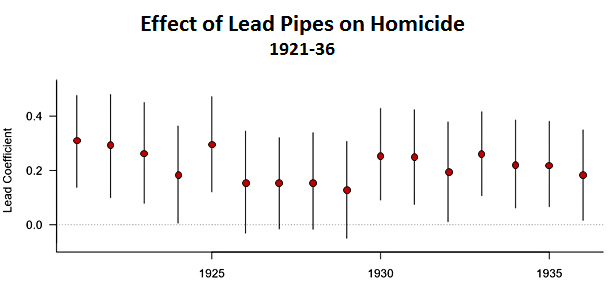Last year I wrote about a paper that looked at the relationship between childhood lead poisoning and violent crime rates in a whole new way. James Feigenbaum and Christopher Muller compared cities from the early 20th century that installed lead water pipes with those that installed iron pipes, and found that cities with lead pipes had higher homicide rates. Today, Josh Marshall alerts me to the fact that Feigenbaum and Muller have now published a final draft of their paper. The basic results are below:

As you can see, the effect is consistently positive. “Based on the lowest and highest point estimates,” the authors conclude, “cities that used lead pipes had between 14 and 36 percent higher homicide rates than cities that did not.” They present further versions of this chart with various controls added, but the results are largely the same. Overall, they estimate that cities with lead pipes had homicide rates 24 percent higher than cities with iron pipes.
As a check, they also examine the data to see if lead pipes are associated with higher death rates from cirrhosis and infant diarrhea, both of which have been linked with lead poisoning:
As expected, we observe large, positive, and statistically significant relationships between a city’s use of lead pipes and its rates of death from cirrhosis and infant diarrhea. Unexpectedly, we find that cities that used lead water pipes had higher rates of death from scarlet fever and influenza. Cities that used iron pipes, in contrast, had higher rates of death from circulatory disease, cancer, and cerebral hemorrhage. We know of no scientific literature to motivate these latter relationships.
So it looks like lead really is the culprit, and it really is associated with higher crime rates.
Click on my post from last year to get more details about both the strengths and weaknesses of this paper. As with any retrospective study like this, there are reasons to be cautious about the results. However, the main strength of this study is unquestionably important: it verifies the lead-crime link in an environment completely different from all the other studies done to date, which examine gasoline lead exposure from 1960-2010. It’s yet more evidence that lead really did play a role in the great crime wave—and the subsequent crime decline—of the second half of the 20th century.
UPDATE: The original version of this post used the wrong chart. It’s now been corrected.














